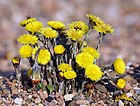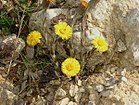Note: This is a project under development. The articles on this wiki are just being initiated and broadly incomplete. You can Help creating new pages.
Difference between revisions of "Tussilago farfara - Colt's Foot"
(→External Links) |
(→Flower) |
||
| Line 39: | Line 39: | ||
===Flower=== | ===Flower=== | ||
| − | {{Flower| | + | {{Flower|Bisexual|2-4cm long|Yellow|5-20|the flower head has tubular disk flowers in the center and ray flowers, these often strap-shaped, around the periphery}} |
===Fruit=== | ===Fruit=== | ||
Revision as of 10:25, 14 June 2019
Tussilago farfara is a plant in the groundsel tribe in the daisy family Asteraceae and it is native to Europe and parts of western and central Asia.
Contents
- 1 Uses
- 2 Parts Used
- 3 Chemical Composition
- 4 Common names
- 5 Properties
- 6 Habit
- 7 Identification
- 8 List of Ayurvedic medicine in which the herb is used
- 9 Where to get the saplings
- 10 Mode of Propagation
- 11 How to plant/cultivate
- 12 Commonly seen growing in areas
- 13 Photo Gallery
- 14 References
- 15 External Links
Uses
Asthma, Laryngitis, Bronchitis, Whooping cough, Eczema, Blotches, Pimples, Diarrhea, Sore throats
Parts Used
Chemical Composition
Tussilagin, Sitosterol, Gallic, tartaric and malic acids, Tannins, Dextrin, Mucus, Mnulin, Flavonoids, Vitamin C[1]
Common names
| Language | Common name |
|---|---|
| Kannada | |
| Hindi | Watpan |
| Malayalam | |
| Tamil | |
| Telugu | |
| Marathi | NA |
| Gujarathi | NA |
| Punjabi | NA |
| Kashmiri | NA |
| Sanskrit | |
| English | Colt's Foot, Coltsfoot |
Properties
Reference: Dravya - Substance, Rasa - Taste, Guna - Qualities, Veerya - Potency, Vipaka - Post-digesion effect, Karma - Pharmacological activity, Prabhava - Therepeutics.
Dravya
Rasa
Guna
Veerya
Vipaka
Karma
Prabhava
Habit
Identification
Leaf
| Kind | Shape | Feature |
|---|---|---|
| Simple | alternate | There is one leaf per node along the stem and basal of the leaves are growing only at the base of the plant |
Flower
| Type | Size | Color and composition | Stamen | More information |
|---|---|---|---|---|
| Bisexual | 2-4cm long | Yellow | 5-20 | the flower head has tubular disk flowers in the center and ray flowers, these often strap-shaped, around the periphery |
Fruit
| Type | Size | Mass | Appearance | Seeds | More information |
|---|---|---|---|---|---|
| 7–10 mm (0.28–0.4 in.) long pome | at least a part of the plume is made up of fine bristles | plume on fruit | {{{6}}} |
Other features
List of Ayurvedic medicine in which the herb is used
- Vishatinduka Taila as root juice extract
Where to get the saplings
Mode of Propagation
How to plant/cultivate
A very easily grown plant, it succeeds in most soils when grown in full sun[3]
Commonly seen growing in areas
Woodland Garden Sunny Edge, Dappled Shade, Hedgerow.
Photo Gallery
References
External Links
- Ayurvedic Herbs known to be helpful to treat Asthma
- Ayurvedic Herbs known to be helpful to treat Laryngitis
- Ayurvedic Herbs known to be helpful to treat Bronchitis
- Ayurvedic Herbs known to be helpful to treat Whooping cough
- Ayurvedic Herbs known to be helpful to treat Eczema
- Ayurvedic Herbs known to be helpful to treat Blotches
- Ayurvedic Herbs known to be helpful to treat Pimples
- Ayurvedic Herbs known to be helpful to treat Diarrhea
- Ayurvedic Herbs known to be helpful to treat Sore throats
- Herbs with Flowers used in medicine
- Herbs with Leaves used in medicine
- Herbs with common name in Hindi
- Herbs with common name in English
- Habit - Perennial herbaceous plant
- Index of Plants which can be propagated by Seeds
- Herbs that are commonly seen in the region of Woodland Garden Sunny Edge
- Herbs that are commonly seen in the region of Dappled Shade
- Herbs that are commonly seen in the region of Hedgerow
- Herbs
- Ayurvedic herbs that don't have seed photos
- Asteraceae
















